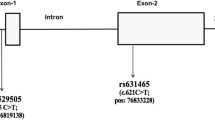Abstract
We investigated the allele and genotype frequencies of two common CRTH2 single nucleotide polymorphisms (SNPs) [G1544C and A1651G (rs 545659)] in the 3′-untranslated region and the relationship between these SNPs and serum IL-13 levels in Chinese children patients with asthma. For G1544C and A1651G SNPs, there were significant differences in allele and genotype frequencies between asthma patients and controls. Haplotype analysis yielded additional evidence of linkage disequilibrium for the 1544G–1651G haplotype (P < 0.01). Moreover, serum IL-13 levels were significantly different among genotypes in G1544C, A1651G SNPs. These results suggest that SNPs of G1544C and A1651G might be act as susceptibility genetic factors of asthma.
Similar content being viewed by others
Abbreviations
- CRTH2:
-
Chemoattractant receptor expressed on Th2 cells
- SNPs:
-
Single nucleotide polymorphisms
- PBMCs:
-
Peripheral blood mononuclear cells
- PDG2:
-
Prostaglandin D2
References
Scirica CV, Celedón JC (2007) Genetics of asthma: potential implications for reducing asthma disparities. Chest 132(5 Suppl):770S–781S. doi:10.1378/chest.07-1905
Blumenthal MN, Ober C, Beaty TH, Bleecker ER et al (2004) Genome scan for loci linked to mite sensitivity: the Collaborative Study on the Genetics of Asthma (CSGA). Genes Immun 5(3):226–231. doi:10.1038/sj.gene.6364063
Liang KY, Hsu FC, Beaty TH (2003) Multipoint linkage disequilibrium mapping for complex diseases. Genet Epidemiol 25(4):285–292. doi:10.1002/gepi.10271
Huang SK, Mathias RA, Ehrlich E et al (2003) Evidence for asthma susceptibility genes on chromosome 11 in an African-American population. Hum Genet 113(1):71–75
Mathias RA, Gao P, Goldstein JL et al (2006) A graphical assessment of p-values from sliding window haplotype tests of association to identify asthma susceptibility loci on chromosome 11q. BMC Genet 7:38–48. doi:10.1186/1471-2156-7-38
Ulven T, Kostenis E (2006) Targeting the prostaglandin D2 receptors DP and CRTH2 for treatment of inflammation. Curr Top Med Chem 6(13):1427–1444
Ly TW, Bacon KB (2005) Small-molecule CRTH2 antagonists for the treatment of allergic inflammation: an overview. Expert Opin Investig Drugs 14(7):769–773. doi:10.1517/13543784.14.7.769
Huang JL, Gao PS, Mathias RA et al (2004) Sequence variants of the gene encoding chemoattractant receptor expressed on Th2 cells (CRTH2) are associated with asthma and differentially influence mRNA stability. Hum Mol Genet 13(21):2691–2697. doi:10.1093/hmg/ddh279
Maeda Y, Hizawa N, Takahashi D et al (2007) Genetic impact of functional single nucleotide polymorphisms in the 3′-UTR region of the chemoattractant receptor expressed on Th2 cells (CRTH2) gene on asthma and atopy in a Japanese population. Int Arch Allergy Immunol 142(1):51–58. doi:10.1159/000095998
Huang JL (2005) Asthma severity and genetics in Taiwan. J Microbiol Immunol Infect 38(3):158–163
Wills-Karp M, Chiaramonte M (2003) Interleukin-13 in asthma. Curr Opin Pulm Med 9:21–27. doi:10.1097/00063198-200301000-00004
Zhu Z, Homer RJ, Wang Z et al (1999) Pulmonary expression of interleukin-13 causes inflammation, mucus hypersecretion, subepithelial fibrosis, physiologic abnormalities, and eotaxin production. J Clin Invest 103(6):779–788. doi:10.1172/JCI5909
Joshi BH, Hogaboam C, Dover P et al (2006) Role of interleukin-13 in cancer, pulmonary fibrosis, and other T(H)2-type diseases. Vitam Horm 74:479–504. doi:10.1016/S0083-6729(06)74019-5
Izuhara K, Arima K, Kanaji S et al (2006) IL-13: a promising therapeutic target for bronchial asthma. Curr Med Chem 13(19):2291–2298. doi:10.2174/092986706777935140
Wills-Karp M (2004) Interleukin-13 in asthma pathogenesis. Immunol Rev 202:175–190. doi:10.1111/j.0105-2896.2004.00215.x
O’Byrne PM, Inman MD, Adelroth E (2004) Reassessing the Th2 cytokine basis of asthma. Trends Pharmacol Sci 25(5):244–248. doi:10.1016/j.tips.2004.03.008
Corry DB, Kheradmand F (2002) Biology and therapeutic potential of the interleukin-4/interleukin-13 signaling pathway in asthma. Am J Respir Med 1(3):185–193
Chiba T, Kanda A, Ueki S et al (2007) Possible novel receptor for PGD2 on human bronchial epithelial cells. Int Arch Allergy Immunol 143(Suppl 1):23–27. doi:10.1159/000101400
Mathiesen JM, Ulven T, Martini L et al (2005) Identification of indole derivatives exclusively interfering with a G protein-independent signaling pathway of the prostaglandin D2 receptor CRTH2. Mol Pharmacol 68(2):393–402
Hirai H, Tanaka K, Yoshie O et al (2001) Prostaglandin D2 selectively induces chemotaxis in T helper type 2 cells, eosinophils, and basophils via seven-transmembrane receptor CRTH2. J Exp Med 193(2):255–261. doi:10.1084/jem.193.2.255
Spik I, Brénuchon C, Angéli V et al (2005) Activation of the prostaglandin D2 receptor DP2/CRTH2 increases allergic inflammation in mouse. J Immunol 174(6):3703–3708
Nath P, Yee Leung S, Williams AS et al (2007) Complete inhibition of allergic airway inflammation and remodelling in quadruple IL-4/5/9/13−/− mice. Clin Exp Allergy 37(10):1427–1435
Ly NP, Li Y, Sredl DL et al (2005) Elevated allergen-induced IL-13 secretion predicts IgE elevation in children ages 2–5 years. J Clin Immunol 25(4):314–320. doi:10.1007/s10875-005-4699-5
Hoshino A, Tsuji T, Matsuzaki J et al (2004) STAT6-mediated signaling in Th2-dependent allergic asthma: critical role for the development of eosinophilia, airway hyper-responsiveness and mucus hypersecretion, distinct from its role in Th2 differentiation. Int Immunol 16(10):1497–1505. doi:10.1093/intimm/dxh151
Author information
Authors and Affiliations
Corresponding author
Additional information
Jinhui Wang and Yongchen Xu should be regarded as joint First Authors.
Rights and permissions
About this article
Cite this article
Wang, J., Xu, Y., Zhao, H. et al. Genetic variations in chemoattractant receptor expressed on Th2 cells (CRTH2) is associated with asthma susceptibility in Chinese children. Mol Biol Rep 36, 1549–1553 (2009). https://doi.org/10.1007/s11033-008-9349-6
Received:
Accepted:
Published:
Issue Date:
DOI: https://doi.org/10.1007/s11033-008-9349-6



